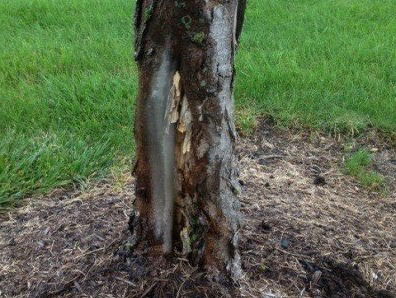Sunscald

What causes this?
This is a common problem throughout the United States wherever there is snow and cold weather. It happens during the late winter and early spring as the temperature fluctuates. The sun warms up the tree trunk, causing the tree’s sap to start flowing. Then the temperature drops in the evening causing the liquid inside to freeze and crack the trunk. This is typically known as sunscald. As you may have noticed, the sun in the winter stays low on the southern side of the hemisphere which is also the side where you most likely will find sunscald damage on younger tree species. You may see this in younger trees such as ash, maple, honey locust, willow, and many fruit trees.
Is there hope?
Sunscald is preventable! There are many good options to protect your trees, some being more effective than others. Many people wrap their tree trunk with a tarp or another pliable material. Softer wrapping material is ideal because it doesn’t damage young tissue while applying or removing it. Wrap trees from the bottom up, so it sheds water instead of collecting it. Some use plastic covers, which can damage tissue and may not to be tall enough to prevent all damage. Covering trees also protects from animals that may be hungry in the winter time and nibble on bark. In the spring time it is important to remember to remove the covering. In orchards, they typically use white paint to reflect the sun’s warming rays, but in your area it may look unaesthetically pleasing.
Remember this!
- Shade your younger tree trunks in the winter
- Always remove the protection in the spring
- Plant the right tree in the right place